Congratulations!
 Congratulations to the lucky, lucky, lucky owners of the inimitable Con Air V! Aero is one of the more wonderful animals in the history of the universe, and we’re so honored to have had him in our lives! Heather Richards photo.
Congratulations to the lucky, lucky, lucky owners of the inimitable Con Air V! Aero is one of the more wonderful animals in the history of the universe, and we’re so honored to have had him in our lives! Heather Richards photo.
 Congratulations to the lucky, lucky, lucky owners of the inimitable Con Air V! Aero is one of the more wonderful animals in the history of the universe, and we’re so honored to have had him in our lives! Heather Richards photo.
Congratulations to the lucky, lucky, lucky owners of the inimitable Con Air V! Aero is one of the more wonderful animals in the history of the universe, and we’re so honored to have had him in our lives! Heather Richards photo.
I have a hypothesis. And it’s only a hypothesis and not a theory because I have 0 data to back this up. But bear with me.
Everyone is always looking for some version of this horse: 8-15 years old, amateur temperament, easy to ride, trained to Prix St. Georges. We’ve never, ever had enough of them to satisfy the market. But man oh man, lately it’s like… where are they?
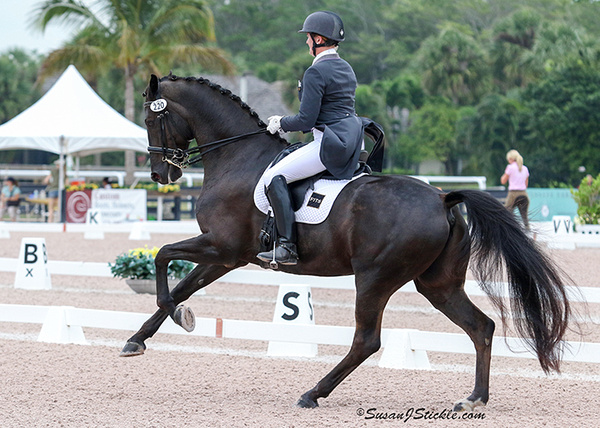
I could sell ten Fenders a day, if I had them to sell. Sue Stickle photo.
Now to the math part, and a trip on the Wayback Machine. Remember when the bottom fell out of the economy between 2008 and 2010? Horse breeders and horse trainers were affected, just like everyone else, so breeders made fewer babies between 2009 and 2011, and fewer quality trainers could afford to give the horses born in the few years before the the right start. Great horses are made between ages 3-6; from there, even if they’re waylaid for a few years, they can still make it up the levels, but if they don’t get pressure applied in the right way, and learn how to learn in those formative years, it makes the journey up the levels really hard.
So that economic downturn would have affected horses, roughly, born between 2003 and 2011. And in 2022, those horses would be between 11 and 19 years old, particularly at the bottom of that range.
There’s a million other factors about why good horses are so hard to find right now, and the demand for youngstock is wild too. But the trickle down effect of that economic downturn might be a factor as well (and, unfortunately, one I don’t know how to solve!)
But certainly if you’ve got the time and the funds to invest in a quality young horse and park it under someone competent to make it, now’s a heck of a good time. Well trained horses will always be marketable!
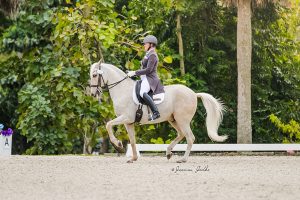
Joanna Jodko photo.
It’s the beginning of a new year, and for those of us with horses, it means thinking about what we’d like to achieve with them and mapping out how to get there. Show calendars are online, and I put together a schedule for where my group of riders might go to show. There’s qualifying criteria for the various regional and national-level championships, including lists of shows for those championships that are dedicated qualifying events. And there’s the long, hard look in the mirror about where a horse or rider is at this moment and what reasonable progress might occur between now and that first show, to set a realistic goal for the season. Here’s how we do it at my house.
Read the rest at The Chronicle of the Horse!
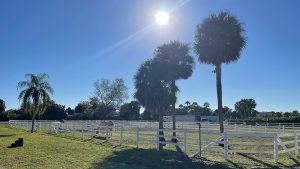 I took you all through the insanity of the past few months in my last blog. Now join me on the past few weeks: our trip to our winter location outside Wellington, Florida.
I took you all through the insanity of the past few months in my last blog. Now join me on the past few weeks: our trip to our winter location outside Wellington, Florida.
This is, I believe, my 10th consecutive winter in Welly-World, so I’m not a rookie. But this year is different on a few fronts. While we’ve taken more horses every year, this is the first year where we’ve had so many going—and so few left behind—that we decided to close my Virginia operation down. This required a lot of shuffling, to get our handful of non-Florida-bound horses to their winter gigs, and a little creativity with my staff and where they were going.
This year is also different because it is the first at a new facility for us: Perfect Cadence, bought this spring by amazing longtime clients and friends. It’ll be amazing; they’re committed to turning the farm into a world-class facility with a covered arena, substantial turnout, a hacking path around the whole facility and more. The problem? Between all the challenges of getting plans approved by Palm Beach County and an HOA under normal circumstances, plus the joys of building during a global health crisis, we are pretty much nowhere. We have the existing farm, which is perfectly lovely, but we’ve never been there before, so everything will be a first-time experience.
But we have a plan. First, the great exit, in stages.
Read the rest at The Chronicle of the Horse!
Hello from Florida. We’re here. We’re set up. We’re riding, I’m teaching, I’m occasionally running out to grab something from Target or Lowe’s or the tack shops that we forgot. I’m exercising, I’m clawing my way out of my inbox, I’m making food and walking my dogs. I’m living my life. And I’m happy and healthy and well.
But man oh man, I am not writing.
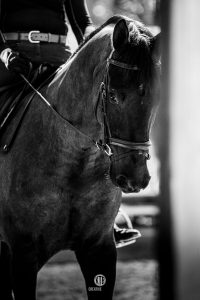
At least I’m not writing well. I’m working on three different blogs, and I’m happy with none of them. The secret to my writing success over the years has been to never have a deadline, never be assigned a subject, and hardly ever take a second pass at anything. It’s why I can’t do it for a living, by the way, because that’s a pretty poor recipe for reliable job performance. But there’s a trope I like: my approach to writing is like a fart. If I have to force it, it’s probably shit.
And here I am, forcing it.
I’ve had three different people ask me if I was ok because I hadn’t published a blog lately. And it’s funny, because I am, truly, fine. It’s also funny because, sometimes, I do my best writing when I’m really distraught. And it’s not like I haven’t had things to be distraught about – staffing challenges, financial challenges, the normal chaos of running one’s own business. But the longer I do this, the thicker the crust I’ve built to keep these things from really making me nutsy. The awfulness of 2016-2018 for me made me tougher, for sure! That which does not kill us and all, bla bla bla. It’s not like 2020 and 2021 haven’t been horribly wretched for a whole lot of people on a whole lot of fronts. I’ve just gotten better at handling it. And as such, apparently, I’ve had less to write about.
(Yes, I recognize the scary universe-tempting that I’m doing. I lean into chaos.)
So don’t worry about me. I’m here, going about my business, living the safest life I can (get your boosters and wear a mask, ya filthy animals!), and just also writing very, very poorly. When I get my writing mojo back, you’ll know it, because these pieces have the potential to be really quite good. They’re just definitely not right now.
 Folks, it’s crazy time. Autumn is always a little nuts, but… well, let me show you.
Folks, it’s crazy time. Autumn is always a little nuts, but… well, let me show you.
Let us begin in OCTOBER. Activities include the GAIG/USEF Regional Championships (amazing and educational); a clinic at my farm with my fantastic friend and biomechanics expert Suzanne Galdun (amazing); and attending the U.S. Para-Dressage National Championships (educational).
My assistant trainer, who is newly engaged, gives me her notice—a surprise, since we’d originally planned on her departure after Florida— leaving me scrambling. It’s OK; I’m at my best with my back against a wall. And sometimes the universe hands you what you need: Three days later I’ve hired Sam, who’s both a beautiful and experienced rider, and while she’s never taught before, she’s got the right temperament and intellect for the job. And I like teaching, so I’ll teach her how to teach.
It remains a good thing I’m at my best with my back against the wall, because I also get fantastically unloaded off a young horse and earn myself my first concussion. Naturally, I do not tell anyone and just casually teach in sunglasses for the next few days. The timing is good because everyone hits pause on their lessons this time of year. I’m fine. Everything’s fine.
Read the rest at The Chronicle of the Horse!
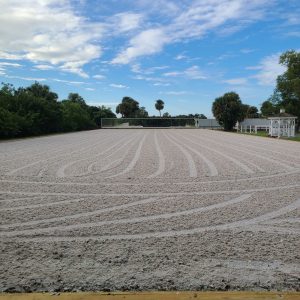 Keep making progress this winter! Between a southern training opportunity and our winter arena rentals, we’ve got lots of ways to keep you moving towards your 2022 goals. Click to read more, and sign up to receive our monthly-or-so newsletter directly in your inbox!
Keep making progress this winter! Between a southern training opportunity and our winter arena rentals, we’ve got lots of ways to keep you moving towards your 2022 goals. Click to read more, and sign up to receive our monthly-or-so newsletter directly in your inbox!
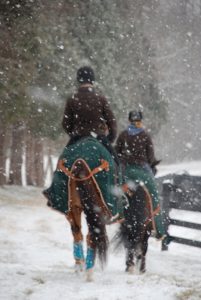 It’s the Most Wonderful Time of the Year! The time where you have to figure out how to not go into debt while also showing your love and appreciation for those you care about, and also where here in Virginia it’s 40* during the day but 20* at night so the ground is a shoe-sucking quagmire. (Ok, so maybe it’s the Second Most Wonderful Time of the Year. Or the Third. Whatever.)
It’s the Most Wonderful Time of the Year! The time where you have to figure out how to not go into debt while also showing your love and appreciation for those you care about, and also where here in Virginia it’s 40* during the day but 20* at night so the ground is a shoe-sucking quagmire. (Ok, so maybe it’s the Second Most Wonderful Time of the Year. Or the Third. Whatever.)
I can’t solve the shoe sucking problem, but I can make some recommendations on what the horse professionals in your world would appreciate if you’re working on your holiday gift list.
1. New gloves. I can basically guarantee that your trainer and/or her working students needs new gloves. In our line of work even the best of the best don’t last all that terribly long, and we try and squeak as much time out of each pair as possible. I ride in Roeckls myself, and if you live in a place that experiences a cold winter, I can’t say enough nice things about the Roeckl-Grip Winter glove, which is on sale at Tack of The Day. They’re not so bulky that you can’t still feel the reins while riding. Love ’em.
2. A MIPS helmet. The science on MIPS technology is amazing – it is HUGELY better at protecting your brain in a fall than even the best of the ASTM approved helmets, and OneK makes one that’s not wild expensive (plus it comes with the fun CCS system so you can swap out the colors on the center details and make your hat your own).
3. New boots from Kingsley. Want to splurge on your favorite horse professional? Kingsley boots are my favorite, because they wear like iron, AND you can be as garish (or not) in your footwear choices because there’s colors and styles galore, at a range of price points. Plus, hypothetically speaking, playing with the Boot Configurator after a couple of cocktails is a barrel of fun. Not that I would know, of course.
4. Some self care. Book a session to care for your favorite rider (or favorite rider’s horse’s) body with an expert bodyworker like Meghan Brady, or their brain with an expert professional coach like Jen Verharen. Both of these amazing women keep me going, in more ways than one.
5. A custom saddle plate from Swanky Saddlery. I LOVE my fancy little logo plates, and they set my black saddles apart in a sea of black saddles. And it’s something that we professionals would never treat ourselves to.
6. Cash and gift cards are never the wrong answer, and I love shopping small whenever I can. Don’t forget that it’s possible to get gift cards to your trainer’s feed store, which we probably spend more money at than our local tack shop. And most veterinary practices will let you make a payment on your trainer’s account as well. And for the working students of the world, think about helping in the direction of the grocery store or gas station, especially in this tricky world we’re living in now. They’d be very grateful for the help!
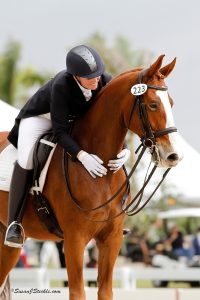 I was 19 or 20 years old, working summers for my childhood trainer outside Chicago. He’d been sent this shrimpy little three year old KWPN Harness-type stallion, cheeky as hell, lightly broke, and very, very spooky. I had to lead him with a whip, not because I was afraid of him, but because he wanted to balk and hide behind me as he walked. We restarted him, and then I had to have someone in the arena with a lunge whip for a while, because he’d suck back so badly about the corners of the indoor that I couldn’t make him go without assistance. He was a nuisance in the gelding field, constantly pestering the big draft cross – appropriately named Thunder – who had heretofore quietly run the herd with benevolence and grace, and instead had to contend, daily, with this annoying little Midge of a Dutch Horse… which led to his nickname. And when I went back to college in the fall, I didn’t give him a second thought.
I was 19 or 20 years old, working summers for my childhood trainer outside Chicago. He’d been sent this shrimpy little three year old KWPN Harness-type stallion, cheeky as hell, lightly broke, and very, very spooky. I had to lead him with a whip, not because I was afraid of him, but because he wanted to balk and hide behind me as he walked. We restarted him, and then I had to have someone in the arena with a lunge whip for a while, because he’d suck back so badly about the corners of the indoor that I couldn’t make him go without assistance. He was a nuisance in the gelding field, constantly pestering the big draft cross – appropriately named Thunder – who had heretofore quietly run the herd with benevolence and grace, and instead had to contend, daily, with this annoying little Midge of a Dutch Horse… which led to his nickname. And when I went back to college in the fall, I didn’t give him a second thought.
Over the winter, the breeder – his owner – passed away, and my mother, apparently looking for a way to punish me, bought him (with no pre purchase exam, by the way), and declared him my college graduation project. I rolled my eyes and said fine, geld him, and I’ll deal with the madness when I come home in the Spring.
Gelding improved things. So did turning four. He grew to the towering height of 16h, and become actually very pleasant. I taught lessons on him. I jumped him over tiny things. I won things at horse shows. I left him in Illinois to grow up while I was a working student for Carol Lavell, and I figured I’d pick him back up in the Spring of his five year old year, do a few more shows, and sell him.
That was a nice thought I had. But at five, Midge – real name Victorious – became an absolute monster. No longer balky but still definitely spooky, I had to put him in the double bridle because, even though he was still maybe only 16.1 and I’m a big, strong lass, I could not stop him. He was strong as an ox, hot as hell, and couldn’t maintain an uphill balance at the canter unless he was going at warp speed. Famous people told me to get rid of him, so I put him on the market, and somehow, someone was just crazy enough to vet him. It was then that we discovered a chip in the right stifle, and so they passed. I went to my mom and said well, we’re stuck with him now, so I guess I’ll have to train him.
He was an extremely quick study, thank God. Midge learned his changes in a minute, and half steps about a minute after that. But he was so, so hot to the leg. I would tell people along the way that I put my leg on at the mounting block and took it off when he turned 10. And he was, much to my dismay, incredibly balanced on his hind legs. He could stand up and stay there, like something out of the Spanish Riding School, for as long as he chose, and I’d just sit up there and wait for him to land.
I was young and brave and I stuck it out. He showed Third Level. He showed Prix St. Georges. Along the way, his wagon horse roots kept his knees and hocks bending, but he learned how to canter, learned how to really piaffe (without a whip, by the way – if you tried to carry one, you’d die.) He got eliminated once at Prix St. Georges because he stood up for so long that the judge feared for my life. Another time a judge told me that it was time for me to stop riding rogues and try and ride nice horses for a change. But by then I was smitten, and you couldn’t have pried him out of my hands with a crowbar. I rode him bareback in the snow. I took him swimming in the pond. He was the pony I’d never had as a kid – stubborn like a pony, aggravating like a pony, but utterly my pony.
He made his Grand Prix debut at 10, including a ticket to the first ever Developing Grand Prix Championships. He learned to make extended trot. His piaffe and passage were phenomenal, and the entire canter tour was all 7.5 or better, every time. An Olympian approached me to ask if he was for sale. The president of the 2012 Olympics ground jury said he was in love. At 11, in the early days of the Adequan Global Dressage Festival, Midge won an open Grand Prix class in the international arena in front of the 5* judging panel, beating a class of team riders. And two days later, he just wasn’t quite right. We chased it around for 2 years – first lame behind, then in front, problem after problem. I couldn’t do it anymore – the heartache, the time, the money. I sent him to the retirement field, with the idea that I’d look at him again in six months, but I figured he was done.
But Midge was not done. He came out of the field remarkably sound. And at the same time, a student named Liza came to the end of a bad string of her own horse luck, with two horses suffering from career-ending health conditions. Horseless, and one 3rd Level score away from her USDF Bronze Medal, I made her a deal: take Midge. If he breaks, no worries, he can go back to the field. As long as he stays sound, he’s yours.
Liza’s care and ministrations were meticulous. He came back, and while he was still hot and feral, time had mellowed him to the point of being vaguely dependable. They showed Third Level. She earned her Bronze, and he still looked good, so we said hey, let’s try Fourth. Then Prix St. Georges. Her USDF Silver Medal. He was still holding steady, so I sold him to Liza – for $1. Then they showed Intermediate II. Then Grand Prix, and her Gold Medal. Maybe we should be done, we thought.
But Midge was not yet done. COVID caused us to hit pause on competing him in 2020, but he continued to teach his family, and tortured more than one working student into tears as they tried to just do simple, low level work. He did Grand Prix demos, and became internet famous for a few one handed stupid pet tricks. This summer, at the age of 19, he took one of my employees around at Grand Prix as well. And only then did he start to show his age. There was a spot of not-quite-right behind that we could have gone on medical safari to treat, but with nothing left for him to give (and also because the little stinker was such a menace to the lower level girls), his amazing owner decided instead to send him back to the retirement field, this time for good.
Naturally, he bucked and squealed his way around his last few weeks with us, and then bronc’d his way around the field, stirring up the other senior citizens. But to the end of his time as a riding horse, he bore the look of eagles. And I’m so grateful for all of the amazing people who have provided loving homes for the horses I’ve brought up the levels, but the decision to retire, such a hard one already, is so much better made 6 months or 9 months or 12 months too early than five minutes too late.
Cheers, Midge. You, eventually, kicking and screaming, made believers out of everyone you met. Enjoy your golden years being your naughty pony self.
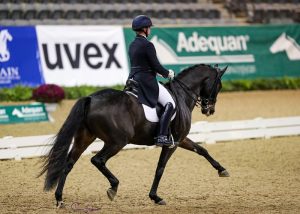 The U.S. Dressage Finals is one of my favorite shows, for a few reasons. It’s a big-deal show, at a fantastic venue. The team that runs it is the All-Stars, the best of the nation’s various show management companies all coming together. It’s a great way to get the young horses some mileage in a big environment, and success here is a nice feather in your marketing cap. But none of those are the biggest reason I love the U.S. Dressage Finals. Let me explain.
The U.S. Dressage Finals is one of my favorite shows, for a few reasons. It’s a big-deal show, at a fantastic venue. The team that runs it is the All-Stars, the best of the nation’s various show management companies all coming together. It’s a great way to get the young horses some mileage in a big environment, and success here is a nice feather in your marketing cap. But none of those are the biggest reason I love the U.S. Dressage Finals. Let me explain.
Read the rest at The Chronicle of the Horse!